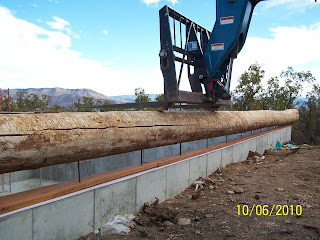We haven't had any precipitation in almost 4 months, so of course this week it has rained every single day. There wasn't much we did this past week when it
wasn't raining and windy. But, the second log was especially bad! It was pouring rain, windy, and there was some thunder and lightning. Being up on the edge of a mountain with a huge log with metal rods sticking out of the end didn't seem like the safest place....
So, there aren't any pictures of us actually putting the second log on! But, here it is, complete.

The third log is the downhill side. I was pretty nervous about taking the forklift down there at all, because they had to build up the dirt just to get to the floor level of the basement. So, there's the slope down, but that is all added in dirt and thus somewhat soft. Then, there's a steep dropoff back down to the real hillside. There's just enough room to sort-of maneuver the forklift.
This was the view from my vantage point inside the forklift. Thank goodness for those strong straps because if one of those would have broken not only would the log have fallen on me, I would have also toppled down the side of the mountain!
Three logs on!
And we're done with the first course!






















































